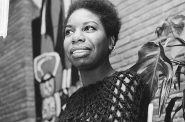The Girls In The Band
The impeccably researched documentary sheds light on a little-known hiccup in the history of jazz: the refusal to accept female musicians.
 Judy Chaikin’s The Girls In The Band presents the alternate history of American Jazz: the story of female jazz musicians and their various struggles. Exhaustively researched, the award-winning film presents a thorough history of women in jazz, right up to the present.
Judy Chaikin’s The Girls In The Band presents the alternate history of American Jazz: the story of female jazz musicians and their various struggles. Exhaustively researched, the award-winning film presents a thorough history of women in jazz, right up to the present.
The film begins in the late 1930s, following musicians such as trumpet players Clora Bryant and Billie Rogers, drummers Viola Smith and Jerrie Thill, saxophonists Rosalind Cron and Peggy Gilbert, and trombonists Helen Woods and Jessie Bailey. Each woman gives a detailed account about how they first became interested in jazz music, and how difficult it was to attain acceptance.
“I never, ever saw another girl do what I did,” says Billie Rogers. “I was in my 20s before I even saw another girl play a trumpet.”
Respect did not come easily, as Clora Bryant recalls: “That was just an unwritten law that [bands] wouldn’t hire any women.”
Peggy Gilbert remembers temping for one band who ultimately didn’t hire her on a permanent basis: “They said ‘We don’t want a girl around. We can’t talk the way we want to talk. We don’t girl musicians, and besides, they can’t play very well.’”
With the advent of World War II, things improved somewhat for female musicians, mainly due to the sudden scarcity of male performers. With the end of the war came the return of male dominance on the jazz scene, and the end of prosperity for many working female musicians, as Viola Smith suggests: “That was the end of that wonderful era. It seems that a lot of girls had to go back to the kitchen.”
More recently, women in jazz, such as Patrice Rushen, have encountered a greater deal of acceptance: “By the time I was out there, there was this consciousness of possibilities. You were beginning to see that the ideas of what a woman could or couldn’t do were being knocked down.”
Nowadays, the success of Hiromi Uehara, Esperanza Spalding, and Diana Krall have minimized the role that gender plays in the careers of jazz musicians. As composer Maria Schneider put it, “I never thought of myself as a woman doing what I’m doing. When I put out my first record, I remember a journalist asked me ‘What’s it like to be a woman composer?’ I said ‘What’s it like to be a male journalist?’”
The Girls in the Band shows at the Oriental Theatre at 4:45 p.m., Thursday October 3 and at Fox Bay Cinema at 5 p.m., Tuesday October 8. Tickets are $10, $9 for students/seniors, available online or on-site, while supplies last.
Movies
-
Milwaukee Film Festival Returns in April
 Mar 27th, 2024 by Sophie Bolich
Mar 27th, 2024 by Sophie Bolich
-
Nina Simone’s Summer of Soul
 Nov 29th, 2022 by John Sieger
Nov 29th, 2022 by John Sieger
-
The Surprise Pick for Best Picture
 Mar 22nd, 2022 by Dominique Paul Noth
Mar 22nd, 2022 by Dominique Paul Noth




















